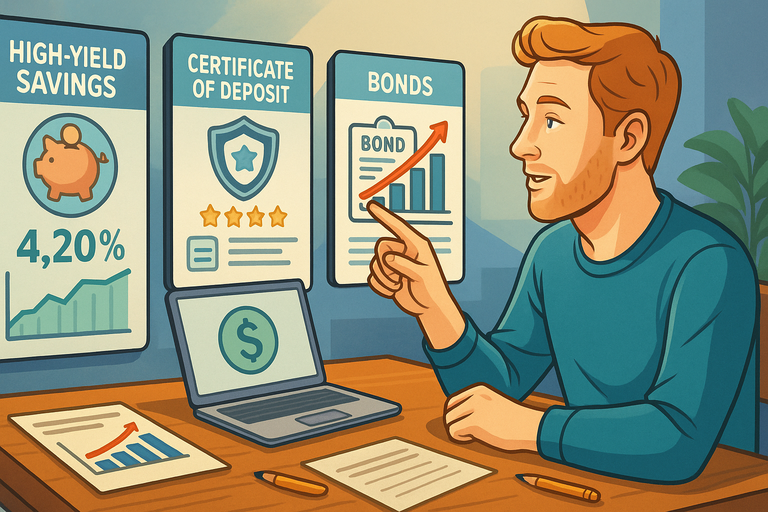Table of Contents
If you’ve been searching for safe ways to grow your money, you’re probably wondering: how do you build wealth without taking on unnecessary risks?
Is it really possible to balance growth with safety, especially when markets seem unpredictable? The good news is, you don’t have to gamble with your future to see steady financial progress.
In this guide, I’ll walk you through five proven strategies that can protect your money while setting you up for long-term wealth.
1. Build Wealth Through High-Yield Savings Accounts
High-yield savings accounts are one of the safest ways to grow your money while keeping it liquid.
They’re a great starting point for anyone who wants to protect their cash from inflation without exposing it to big risks.
Why High-Yield Savings Accounts Are Safer Than Traditional Options
A traditional savings account at a local bank usually pays close to nothing in interest — sometimes as low as 0.01%. That means if you leave $10,000 in there for a year, you might earn just a single dollar.
A high-yield savings account, on the other hand, often pays 10–20 times more, while still being FDIC insured (up to $250,000 per depositor, per bank).
Safety comes from two things:
- Your money is federally insured, so even if the bank fails, your deposits are protected.
- Unlike stocks or real estate, your balance never goes down. You won’t wake up to find your account worth less than the day before.
If you’re someone who wants steady, worry-free growth, this is one of the easiest moves you can make. I always suggest keeping your emergency fund here so it grows without being locked up.
How Online Banks Often Provide Better Interest Rates
Brick-and-mortar banks carry heavy overhead — branch staff, real estate, utilities. Online banks don’t have that burden, which means they can pass more savings back to you in the form of higher interest rates.
For example, if a traditional bank is offering 0.05% APY, an online bank might pay 4% or more. On $20,000, that’s the difference between earning $10 a year and $800 a year. Same money, just placed in a smarter spot.
Most online banks have mobile apps that make managing your account easy:
- You can set up direct deposits to fund your savings automatically.
- Transfers to your checking account are typically completed in 1–3 days.
- Some even give you goal-setting dashboards where you can label buckets like “Vacation Fund” or “New Car.”
Setting Up Automatic Transfers To Grow Consistently
Consistency beats effort when it comes to saving. If you have to remember to move money every month, chances are you’ll skip it when things feel tight. Setting up automatic transfers solves that problem.
Here’s how you can do it:
- From your checking account dashboard, find the “Transfers” or “Payments” option.
- Select your high-yield savings account as the destination.
- Choose an amount you can stick to every month, even if it’s just $50.
- Set the transfer to repeat on payday, so the money moves before you spend it.
Over time, those small, automatic moves snowball. Let’s say you set $200 to transfer automatically each month into a 4% APY account.
After a year, you’d have $2,400 in contributions plus around $50 in interest. That’s effortless growth, and the longer you leave it, the stronger it compounds.
2. Invest In Certificates Of Deposit For Guaranteed Returns
Certificates of Deposit (CDs) are another safe way to grow your money, especially if you know you won’t need access to it for a set period.
They pay a fixed interest rate in exchange for locking in your funds for a specific term.
How CD Terms Work And What To Expect In Growth
CDs are simple: you deposit a lump sum, choose a term (anywhere from 3 months to 5 years), and agree not to withdraw until the term ends. In return, the bank guarantees you a fixed interest rate.
Let’s say you invest $5,000 into a 2-year CD paying 4%. At the end of the term, you’d get your $5,000 back plus $400 in interest. Unlike stocks, there’s no risk of losing principal. The tradeoff is liquidity — your money is locked until maturity.
One thing I’ve noticed: banks often pay higher rates on longer terms. But before jumping on a 5-year CD, think about whether you can realistically leave the money untouched.
Laddering CDs To Keep Money Accessible Yet Growing
If locking away your cash makes you nervous, laddering is a strategy that balances growth with access. Here’s how it works:
- Split your investment across multiple CDs with different maturity dates.
- For example: put $1,000 in a 1-year CD, $1,000 in a 2-year CD, and $1,000 in a 3-year CD.
- When the 1-year CD matures, you can either cash out or roll it into a new 3-year CD.
This creates a rotation where every year, one of your CDs matures and frees up funds, while the rest keep earning higher long-term rates.
I like this method because it avoids having all your money tied up at once.
Balancing Liquidity And Safety With CD Investments
CDs are best used for money you don’t need right away but still want to keep safe. They’re especially smart for medium-term goals — like saving for a down payment in 3 years.
To strike the right balance:
- Keep your emergency fund in a high-yield savings account for quick access.
- Use CDs for money you want to protect and grow without market risk.
- Ladder them if you want flexibility without sacrificing returns.
It’s about matching your money to your timeline. Short-term needs belong in savings, while CDs are perfect for predictable future expenses. That’s why I think of CDs as the “bridge” between savings accounts and investments in stocks or funds.
3. Grow Steadily With Bonds And Bond Funds
Bonds are like the steady heartbeat of investing — not flashy, but dependable.
If you want safer ways to grow your money while still earning more than a savings account, bonds and bond funds are worth considering.
Why Government And Municipal Bonds Are Considered Low Risk
When you buy a bond, you’re essentially lending money to an institution (like the U.S. government, a state, or a corporation) in exchange for regular interest payments.
Government bonds, especially U.S. Treasury bonds, are considered some of the safest investments in the world because they’re backed by the full faith and credit of the government.
Municipal bonds — issued by cities and states — often come with an added perk: the interest you earn can be tax-free at the federal level, and sometimes even state and local levels if you live where the bond was issued. For someone in a higher tax bracket, that can make a huge difference in after-tax returns.
Here’s the tradeoff: bonds are safer than stocks, but they usually offer lower returns. Think of them as your portfolio’s “seatbelt” — they might not accelerate wealth like equities, but they’ll protect you when markets get bumpy.
How Bond Funds Provide Diversification Without Complication
If choosing individual bonds feels complicated, bond funds simplify the process. A bond fund is a pool of many bonds managed by professionals, and you can buy into it the same way you’d buy a stock or index fund.
The advantage? Diversification. Instead of tying up money in a single bond, you’re spreading your risk across dozens or even hundreds of bonds. If one issuer defaults, the impact is minimal.
Bond funds are also more liquid — you can buy and sell shares any time through your brokerage account. With individual bonds, you’d need to hold until maturity or try to sell on the secondary market, which can be trickier.
From what I’ve seen, a total bond market index fund is a simple option for beginners. It gives you exposure to government, municipal, and corporate bonds all in one package, without having to handpick.
Comparing Bonds To Stocks For Long-Term Stability
Stocks are exciting because they can grow your wealth faster, but they’re volatile. Bonds, by comparison, are steady — they provide predictable income in the form of interest.
If you put $10,000 into a bond fund yielding 4%, you know to expect about $400 in interest each year. With stocks, that $10,000 could be worth $12,000 next year… or $8,000.
Over the long run, stocks tend to outperform bonds. But the key is balance. For someone close to retirement, shifting more into bonds reduces the risk of losing money right when you need it most. For younger investors, bonds are more about stability and diversification than chasing growth.
I like to think of bonds as the anchor of a portfolio. They won’t take you to new destinations quickly, but they’ll keep you steady while your other investments sail.
4. Use Index Funds For Balanced Long-Term Growth
If bonds are the anchor, index funds are the sails that catch the wind. They’re one of the most effective ways to grow your money steadily, without the stress of picking individual stocks.
Why Index Funds Carry Less Risk Than Individual Stocks
When you buy an index fund, you’re not betting on one company — you’re buying a slice of the entire market (like the S&P 500). That means if one company underperforms, the others balance it out.
Individual stocks can swing wildly. A single bad earnings report can drop the value by 20% overnight. With an index fund, that kind of shock is diluted because you’re spread across hundreds of companies.
That’s why many experts (myself included) recommend index funds as the backbone of long-term investing. They deliver strong returns historically while keeping risk manageable.
How To Take Advantage Of Dollar-Cost Averaging
Dollar-cost averaging (DCA) is a fancy term for investing a fixed amount of money at regular intervals, no matter what the market is doing.
Here’s how you can put it into action:
- Log in to your brokerage or retirement account.
- Set up an automatic investment of, say, $200 every two weeks into your index fund.
- Forget about timing the market — you’ll naturally buy more shares when prices are low and fewer when prices are high.
The beauty of DCA is consistency. Instead of stressing about “Is now the right time to buy?” you just keep feeding your account. Over years and decades, that discipline adds up.
The Role Of Index Funds In Retirement Portfolios
Index funds shine in retirement accounts like 401(k)s and IRAs because they combine growth with simplicity. You don’t have to constantly rebalance or stress over what stock to pick.
A common approach is to use a target-date index fund. You pick the year closest to your planned retirement, and the fund automatically shifts from aggressive (more stocks) to conservative (more bonds) as you age.
If you want more control, you can build your own mix — maybe 80% stock index funds and 20% bond funds when you’re young, slowly flipping that ratio as you approach retirement. The key is that index funds keep things hands-off while still fueling long-term growth.
5. Secure Future Wealth With Retirement Accounts
Retirement accounts are where all these strategies really come together.
They give you the tools to grow your money safely while also reducing your tax burden — a win-win.
Tax Advantages Of 401(k)s And IRAs For Long-Term Growth
The biggest perk of retirement accounts is tax treatment. With a traditional 401(k) or IRA, your contributions are tax-deductible, meaning you save on taxes now while your money grows tax-deferred. With Roth accounts, you pay taxes upfront but withdrawals in retirement are tax-free.
Let’s say you contribute $6,000 to a Roth IRA at age 30 and let it grow at an average of 7% annually. By retirement age (65), that one contribution could grow to over $45,000 — and you won’t owe a penny in taxes when you withdraw it. That’s the magic of time and tax advantages working together.
How Employer Matching Can Supercharge Your Savings
If your employer offers a 401(k) match, take it. It’s literally free money.
For example, if you earn $60,000 and your employer matches 50% of contributions up to 6% of your salary, here’s what happens:
- You contribute $3,600 (6% of your salary).
- Your employer kicks in another $1,800.
- That’s $5,400 growing every year — just for making contributions you’d be wise to make anyway.
I always suggest contributing at least enough to capture the full match. Skipping it is like turning down part of your paycheck.
Choosing The Right Mix Of Investments Within Retirement Accounts
Your retirement account isn’t just about where you save, but how you invest within it. Most plans give you access to mutual funds, index funds, and sometimes company stock.
The general rule of thumb:
- Younger investors can afford more risk, so a higher percentage in stock index funds makes sense.
- As you age, shift gradually toward bonds or balanced funds to protect your nest egg.
Many accounts now offer built-in tools where you can choose your risk level (conservative, moderate, aggressive), and the platform automatically allocates your money. It’s worth experimenting with those options if you don’t want to build your portfolio manually.
Pro Tip To Keep Your Money Growing Safely
No matter which path you choose — savings accounts, CDs, bonds, or index funds — the most important step is consistency. I recommend reviewing your money strategy once a year.
Look at how much you’re saving, whether your risk level matches your life stage, and make small tweaks.
Wealth doesn’t come from one big move; it comes from stacking small, smart decisions over time. If you treat your money with patience and discipline, even the “safe” routes can lead you to long-term financial freedom.






